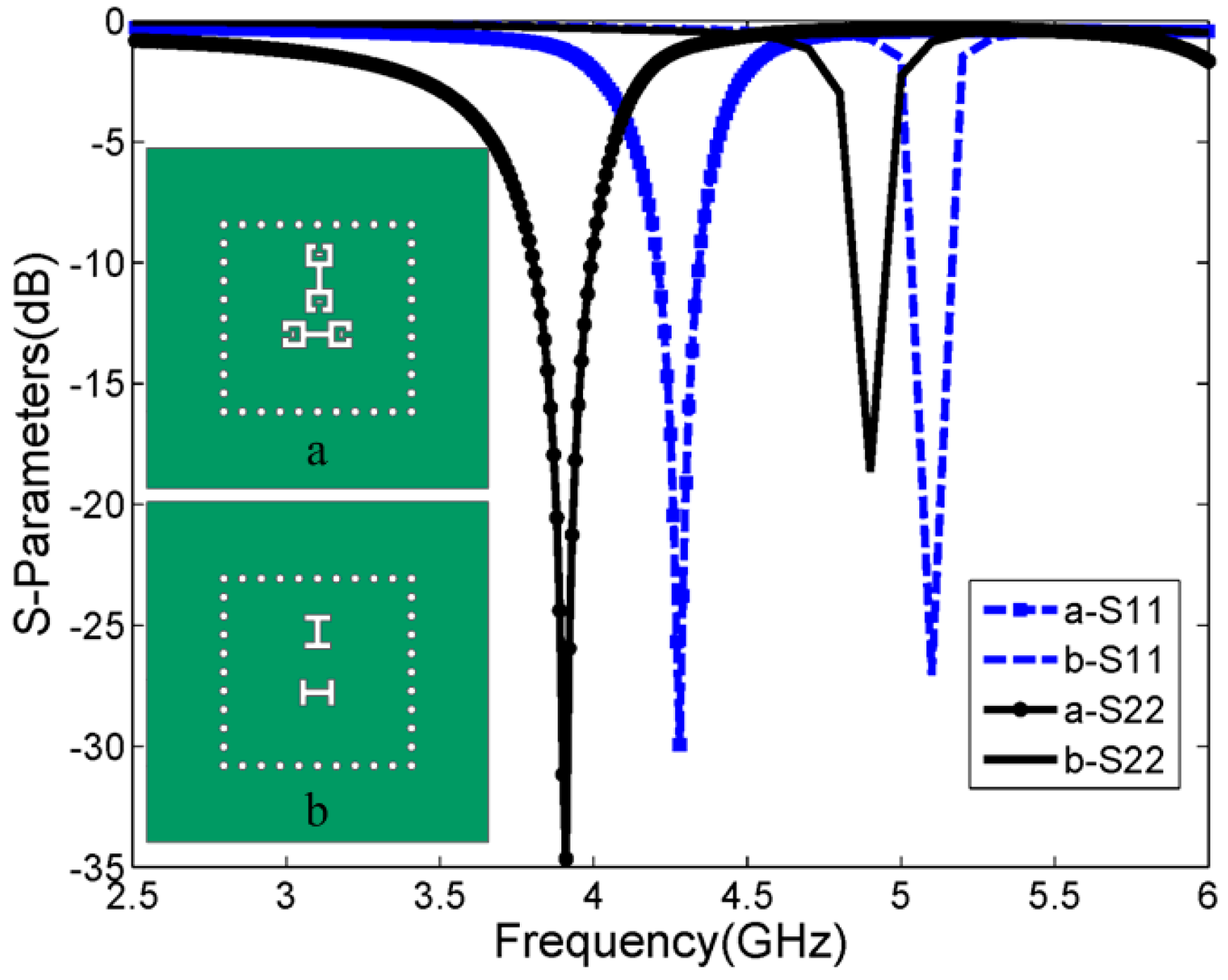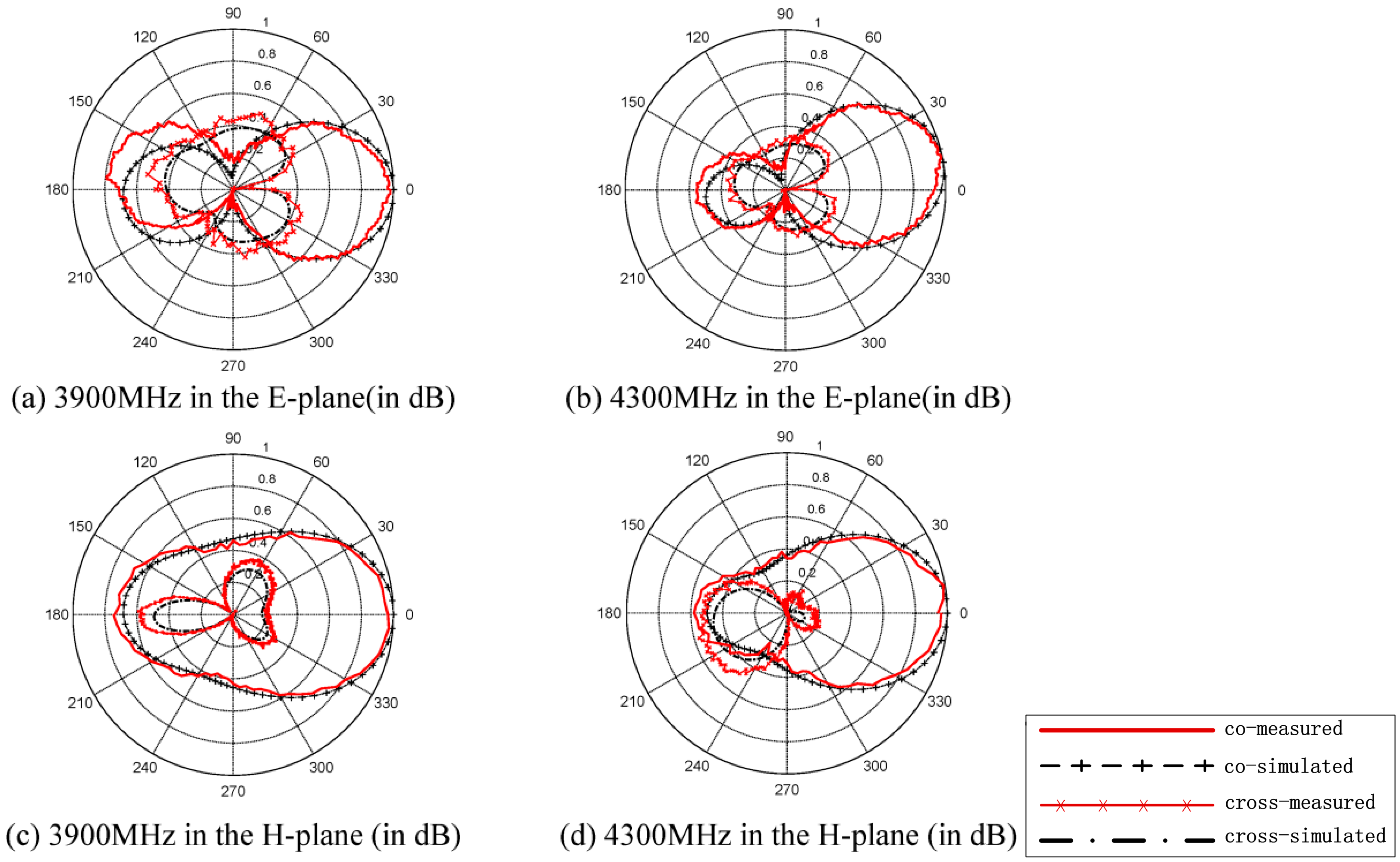A CSRR-Fed SIW Cavity-Backed Fractal Patch Antenna for Wireless Energy Harvesting and Communication
Abstract
:1. Introduction
2. Design Section
2.1. Antenna Configuration and Design Consideration

2.2. Design Evolution
2.2.1. The Influence of the Coupling Aperture

2.2.2. The Influence of the Radiation Patch Shape

3. Results and Discussion


4. Conclusions
Acknowledgments
Author Contributions
Conflicts of Interest
References
- Bozzi, M.; Georgiadis, A.; Wu, K. Review of substrate-integrated waveguide circuits and antennas. IET Microw. Antennas Propag. 2011, 5, 909–920. [Google Scholar] [CrossRef]
- Cao, H.; He, S.; Li, H. A compact wideband bandpass filter using novel CSRR loaded QMSIW resonator with high selectivity. PIER C 2013, 41, 239–254. [Google Scholar] [CrossRef]
- Awida, M.-H.; Fathy, A.-E. Design guidelines of substrate-integrated cavity-backed patch antennas. IET Microw. Antennas Propag. 2012, 6, 151–157. [Google Scholar] [CrossRef]
- Awida, M.-H.; Fathy, A.-E. Substrate-integrated waveguide Ku-band cavity-backed 2 × 2 microstrip patch array antenna. IEEE Antennas Wirel. Propag. Lett. 2009, 8, 1054–1056. [Google Scholar] [CrossRef]
- Awida, M.-H.; Suleiman, S.-H.; Fathy, A.-E. Substrate-integrated cavity-backed patch arrays: A low-cost approach for bandwidth enhancement. IEEE Trans. Antennas Propag. 2011, 59, 1155–1163. [Google Scholar] [CrossRef]
- Razavi, S.-A.; Neshati, M.-H. Development of a low-profile circularly polarized cavity-backed antenna using HMSIW technique. IEEE Trans. Antennas Propag. 2013, 61, 1041–1047. [Google Scholar] [CrossRef]
- Yang, T.-Y.; Hong, W.; Zhang, Y. Wideband millimeter-wave substrate integrated waveguide cavity-backed rectangular patch antenna. IEEE Antennas Wirel. Propag. Lett. 2014, 13, 205–208. [Google Scholar] [CrossRef]
- Zhang, T.; Hong, W.; Zhang, Y. Design and analysis of SIW cavity backed dual-band antennas with a dual-mode triangular-ring slot. IEEE Trans. Antennas Propag. 2014, 62, 5007–5016. [Google Scholar] [CrossRef]
- Li, M.; Lin, X.Q.; Chin, J.-Y. A novel miniaturized printed planar antenna using split-ring resonator. IEEE Antennas Wirel. Propag. Lett. 2008, 7, 629–631. [Google Scholar]
- Islam, M.T.; Islam, M.M.; Samsuzzaman, M.; Faruque, M.R.I.; Misran, N. A negative index metamaterial-inspired UWB antenna with an integration of complementary SRR and CLS unit cells for microwave imaging sensor applications. Sensors 2015, 15, 11601–11627. [Google Scholar] [CrossRef] [PubMed]
- Werner, D.-H.; Ganguly, S. An overview of fractal antenna engineering research. IEEE Anlennas Propag. Mag. 2003, 45, 38–57. [Google Scholar] [CrossRef]
- Oraizi, H.; Hedayati, S. Miniaturized UWB monopole microstrip antenna design by the combination of Giuseppe Peano and Sierpinski carpet fractals. IEEE Antennas Wirel. Propag. Lett. 2011, 10, 67–70. [Google Scholar] [CrossRef]
- Gao, S.-C.; Li, L.-W.; Leong, M.-S. Dual-polarized slot-coupled planar antenna with wide bandwidth. IEEE Trans. Antennas Propag. 2003, 51, 441–448. [Google Scholar]
- Sabri, L.; Amiri, N.; Forooraghi, K. Dual-band and dual-polarized SIW-fed microstrip patch antenna. IEEE Antennas Wirel. Propag. Lett. 2014, 13, 1605–1608. [Google Scholar] [CrossRef]
© 2015 by the authors; licensee MDPI, Basel, Switzerland. This article is an open access article distributed under the terms and conditions of the Creative Commons Attribution license (http://creativecommons.org/licenses/by/4.0/).
Share and Cite
Cao, H.; Jiang, F.; Liu, J.; Cai, W.; Tang, M.; Tan, X.; Yang, S. A CSRR-Fed SIW Cavity-Backed Fractal Patch Antenna for Wireless Energy Harvesting and Communication. Sensors 2015, 15, 21196-21203. https://doi.org/10.3390/s150921196
Cao H, Jiang F, Liu J, Cai W, Tang M, Tan X, Yang S. A CSRR-Fed SIW Cavity-Backed Fractal Patch Antenna for Wireless Energy Harvesting and Communication. Sensors. 2015; 15(9):21196-21203. https://doi.org/10.3390/s150921196
Chicago/Turabian StyleCao, Hailin, Fen Jiang, Jiujiu Liu, Wenbin Cai, Mingchun Tang, Xiaoheng Tan, and Shizhong Yang. 2015. "A CSRR-Fed SIW Cavity-Backed Fractal Patch Antenna for Wireless Energy Harvesting and Communication" Sensors 15, no. 9: 21196-21203. https://doi.org/10.3390/s150921196
APA StyleCao, H., Jiang, F., Liu, J., Cai, W., Tang, M., Tan, X., & Yang, S. (2015). A CSRR-Fed SIW Cavity-Backed Fractal Patch Antenna for Wireless Energy Harvesting and Communication. Sensors, 15(9), 21196-21203. https://doi.org/10.3390/s150921196




